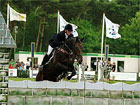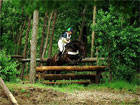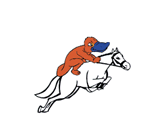Show Jumping

Dressage

Three Day Eventing

Dressage is where riders make their horses do a set of moves. In one part, the riders must ride them to music. The horses look like they are dancing. Dressage is a kind of ballet for horses. It takes many years to train a horse to do dressage.
In cross-country, the horses and riders go up and down hills, along roads and over fences.
